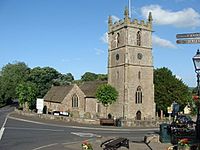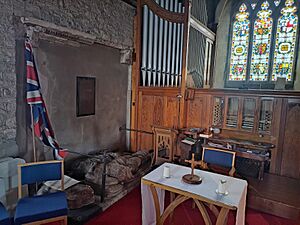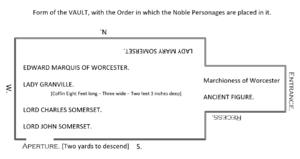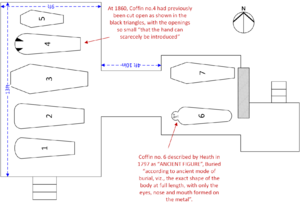St Cadoc's Church, Raglan facts for kids
Quick facts for kids Church of St Cadoc, Raglan, Monmouthshire |
|
|---|---|
| Church of St Cadoc | |

St Cadoc's
|
|
| Lua error in Module:Location_map at line 420: attempt to index field 'wikibase' (a nil value). | |
| Location | Raglan, Monmouthshire |
| Country | Wales |
| Denomination | Church in Wales |
| History | |
| Status | Parish church |
| Founded | C13th-C14th century |
| Architecture | |
| Functional status | Active |
| Heritage designation | Grade II* |
| Designated | 18 November 1980 |
| Architectural type | Church |
| Administration | |
| Parish | Raglan |
| Deanery | Raglan/Usk |
| Archdeaconry | Monmouth |
| Diocese | Monmouth |
St Cadoc's Church is a historic church located in the village of Raglan, Monmouthshire, Wales. It stands at a crossroads in the center of the village. The church was first built by the Clare and Bluet families in the 1200s and 1300s. Later, the Herbert family, who lived at Raglan Castle, rebuilt and made the church bigger in the 1400s. In the 1800s, the church was greatly repaired by an architect named Thomas Henry Wyatt.
The church is built in a style called Decorated Gothic, which means it has fancy decorations. It is a very important historical building, listed as a Grade II* listed building.
Contents
History of St Cadoc's Church
The church has a long and interesting history. Some people believe the very first church on this spot was started by Saint David, who is the patron saint of Wales. However, the church today is named after Saint Cadoc.
The current church building was likely started by the de Clare family. They were early lords of Raglan. The Bluet family finished building it in the 1300s. The church was then made much larger by the Herbert family and later by the Somersets. The Somersets were powerful nobles who became Earls and Marquesses of Worcester, and later Dukes of Beaufort.
The Beaufort Chapel and Tombs
The Beaufort Chapel is a special part of the church on the north side. It was built by the Somerset family. This chapel holds three large tombs of the Earls of Worcester. These nobles were the lords of Raglan and Raglan Castle during the Middle Ages. Their remains are buried in a crypt underneath the chapel.
During the English Civil War, in the 1600s, Parliamentarian soldiers damaged these monuments. The tombs belong to William Somerset, 3rd Earl of Worcester, Edward Somerset, 4th Earl of Worcester, and his wife, Lady Elizabeth Hastings.
Charles Somerset, Marquess of Worcester, who died in an accident, is also buried here. A tablet placed in the chapel in 1868 lists all the Somerset family members buried in the church.
Unique Features and Memorials
The church tower has a unique clock with only three faces. A local writer, Fred Hando, explained that the person who paid for the clock, Miss Anna Maria Bosanquet, refused to add a fourth face. This was because she had a disagreement with the owners of the nearby Raglan Station, which would have been in the direction of the missing face.
There are also several memorials for the Barons Raglan, who lived at Cefntilla Court nearby. One stained glass window remembers the military achievements of FitzRoy Somerset, 1st Baron Raglan during the Crimean War.
Architecture and Design
The main parts of the church, the chancel and the nave, were built in the 1300s. The tall west tower, which is quite impressive, was added in the 1400s. An expert in architecture, John Newman, noted that the tower's corner supports are unusual. He thinks they were built around the same time as similar work at Raglan Castle in the 1460s.
The Beaufort (North) Chapel, where many lords of Raglan are buried, was built in the mid-1500s. The church's original font, used for baptisms, was found buried in a vicar's garden in the 1920s and returned to the church.
Victorian Restoration
Most of the church's current look comes from a major restoration in the mid-1800s. This work was done by Thomas Henry Wyatt in 1867–1868. All the church's stained glass windows are from this period. The restoration was paid for by Henry Somerset, 8th Duke of Beaufort. During this time, the Lady Chapel was also built.
In 2016, when Wyatt's 1800s roof was being repaired, workers discovered an older, late-medieval "wagon-roof" underneath. This type of roof was common in Monmouthshire during the Middle Ages.
The churchyard also has the base and stump of an "unusually fine" medieval cross.
Vicars of St Cadoc's Church
Here is a list of the vicars who have served at St Cadoc's Church since 1560:
- 1560, John Gallin (Gwillim)
- 1635, William Rogers
- 1640, William Davies
- 1661, John Davies
- 1678, Rice Morris
- 1682, William Hopkins
- 1709, Richard Tyler, B.A.
- 1715, David Price
- 1746, John Leach. B.A.
- 1781, Thomas Leach. (died 1796 at Blakeney, Glos.)
- 1796, Charles Phillips, B.A.
- 1818, William Powell, M.A.
- 1866, Arthur Montague Wyatt
- 1874, Henry Plantagenet Somerset, M.A.
- 1893, Charles Mathew Perkins, M.A.
- 1903, Robert Shelley Plant.
- 1924, David James Sproule, B.A.
- 1928, Thomas Wright, B.A.
- 1939, Charles Duck, L. Div.
- 1952, William Joseph Price
- 1958, Arthur Vernon Blake, B.A.
- 1975, Peter Charles Gwynne Gower
- 1991, Simon Llewellyn Guest
- 2005, Joan Wakeling
- 2014, The Rev'd Canon Tim Clement
The Somerset Family Crypt
Beneath St Cadoc's Church is a crypt, a special underground burial chamber, for the Somerset family. In 1868, the 8th Duke of Beaufort placed a tablet in the church listing those buried there:
- William Somerset, 3rd Earl of Worcester, died 1589.
- Edward Somerset, 4th Earl of Worcester, died 1627.
- Elizabeth, his wife, died 1621.
- Edward, 6th Earl and 2nd Marquis of Worcester, died 1667.
- Mary, daughter of Edward, 6th Earl, died as a baby.
- Charles, 2nd son of Henry, 1st Duke of Beaufort, died 1698.
- Edward, 3rd son of the above, died as a baby.
- Henry, 4th son of the above, died 1667.
- Elizabeth, older daughter of the above.
- Rebecca, wife of Charles, Marquis of Worcester, died 1712.
- Mary, daughter of Charles, 2nd Duke of Beaufort, died as a baby, 1685.
- John, 3rd son of Charles, 2nd Duke of Beaufort, died 1704.
Historical Discoveries in the Crypt
The crypt has been explored several times throughout history.
- During the English Civil War (1642–1651), Parliamentarian soldiers entered the vault and damaged some of the tombs. The remains of three statues that were destroyed were later moved to the Beaufort Chapel.
- Before 1797, Charles Heath, a writer from Monmouth, visited the church twice. He found that the floor of the chancel had collapsed, allowing access to the two rooms of the vault. He explored the vault and wrote about what he found. He saw seven lead coffin linings and also found pieces of wooden coffins and metal decorations scattered on the floor.
- On December 11, 1860, Mr. Osmond A. Wyatt, a land agent, opened the vault. He also found seven lead coffin linings. He noted that one of the lead coffins seemed to have been opened before.
- On January 4, 1861, Bennet Woodcroft from the London Patent Office, along with John Macgregor, Wyatt, and others, opened the crypt. They were looking for a model steam engine that Edward, the second Marquis, had asked to be buried with him. They opened two of the seven coffin linings but did not find the model.





